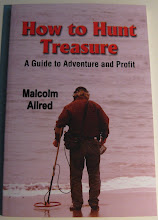By the same token, I also learned to never ignore those big signals by just assuming they’re trash or an old barbed wire fence. Twice in my hobby career (that I recall) I’ve almost walked away from great discoveries when I thought that either my detector was lying to me, or that I’d stumbled across a rusty steel drum buried three or four feet deep.
On one such occurrence, while searching along the riverbank near some early-war Confederate fortifications, I encountered a signal some six feet across. Since you often encounter buried cables, beams, and cast-off metal items from towboats and barges along the riverbank, I came very near to moving on. However, you’re never sure, and just to be sure, I dug. In that hole, which eventually measured some eight feet across, I found 19 Confederate round balls – most were 8” and 9” shells – apparently dumped there some 130 years before. It took two days of digging to get them all out. They were located over a mile from my truck (yes, my ’65 VW, and later my old ’74 Bronco, had been replaced by a pickup truck), so there was no way I could carry one 50 or 60 pound ball that far, much less 19. So I left the balls that day and drove home, scratching my head, trying to figure a good way to move the balls from hole to truck. And I conceived a brilliant plan for relocating 19 cannon balls one-mile distance.
I would use my motorcycle!
It so happened that a railroad track was near my treasure hole, and this same track ran very near where my truck was parked, a mile away. Next afternoon after work I loaded the motorcycle onto the truck, drove to my parking spot, unloaded the bike, road the mile or so to the treasure hole along the crossties between the rails, and loaded a single 8” ball behind the bike’s seat. But 8” cannon balls are HEAVY, and bouncing them along railroad ties on the back seat of a motorcycle can ruin tires, wheels, even frames. The bike and I made it to the truck okay, but the bike was damaged in the process, and would be a total wreck if I continued. I knew I had to come up with a better way.
Of course, I’d thought of using a wheelbarrow, but had already discarded the idea because of the obstacles presented by irregular crossties and loose slag. But another thought occurred to me. The rails were nice and
 smooth… if only I could place the wheel of the wheelbarrow on a rail without its sliding off…
smooth… if only I could place the wheel of the wheelbarrow on a rail without its sliding off…And that’s how I did it. In my shop I fabricated two thin semi-circular steel plates, each about twelve inches in diameter, each with a hole in its center. By fastening the plates on either side of the wheelbarrow wheel, I ensured the wheel would remain on the rail.
Back at the treasure hole I loaded the balls one at a time into the wheelbarrow and easily walked them back to my truck atop a shiny steel rail.
Now, you’re wondering about trains, right? Sure enough, on one trip back I heard a big diesel engine, the sound coming from around a long curve ahead of me. In my haste to remove the loaded wheelbarrow and myself from the rail, the 8” ball fell between the tracks. I watched anxiously from behind a tree as the locomotive approached. Fortunately, the engineer must never have seen it, for the train never slowed, passing right over the old Confederate ordinance. I recovered the ball and continued on my way, eventually unloading all 19 balls in my back yard.

The second large signal I’m happy I decided not to ignore occurred while a friend and I were hunting the fields at the scene of the Battle of Big Black River, east of Vicksburg. The detector whined over an area some ten feet across – not a solid signal, but a series of long, deep, signals that had no sharp ends – meaning (most likely) either heavy, symmetrical iron, or non-ferrous metal. We had dug a number of plow points during the day, so I considered that these were more. But – when you’re not sure, as I said, DIG!
After we had pulled over 6,000 Confederate Minie balls (primarily “Georgia” Minies with teat bases and Enfields with “L2” bases) and musket balls from that one hole, I was glad we had. Apparently, captured Confederates had been disarmed in the area; we also found musket locks and butt plates along with the bullets.
Yes, that's a cold beer in my hand in the photo.



No comments:
Post a Comment